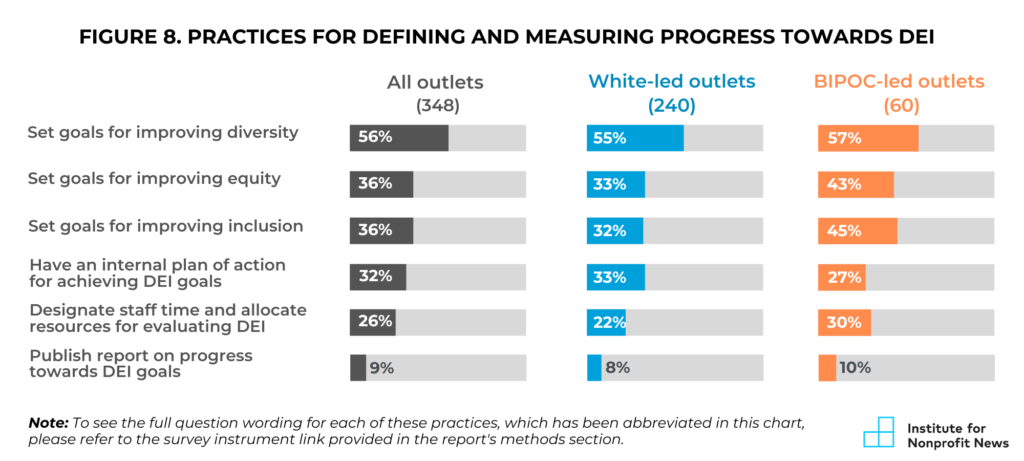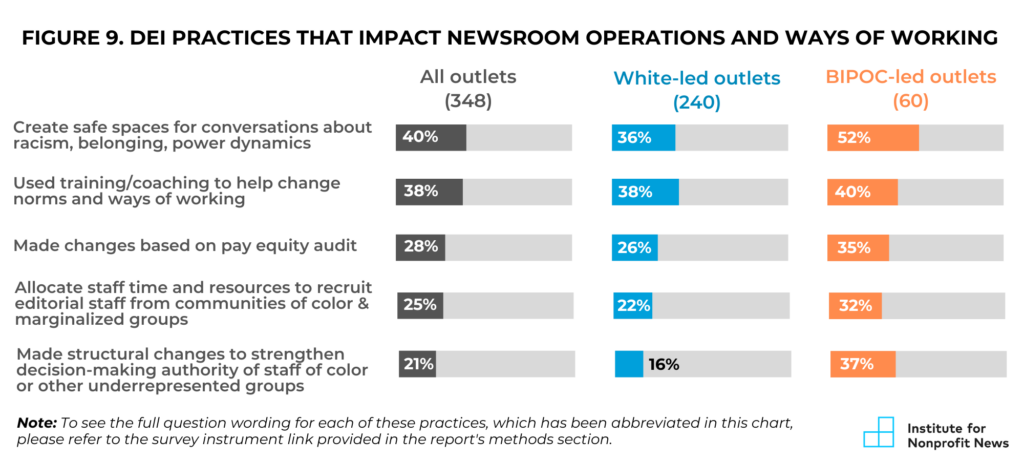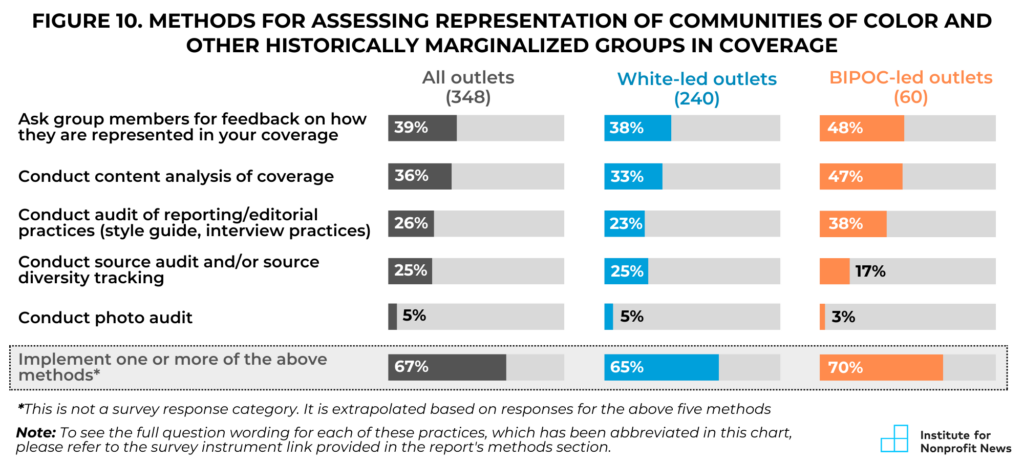DEI Index Report 2023
DEI Practices
In this section, we explore an array of practices intended to support progress towards greater diversity, equity and inclusion — both in terms of how news organizations operate internally and how they relate to the communities they serve.
In gathering data on DEI practices, we acknowledged that meaningful measurement of these practices is difficult.
The temptation is to ask about easily measurable activities that can be “checked off” as completed or not. It is harder to capture the longer-term and nonlinear process through which news outlets can become more diverse, equitable and inclusive. This includes shifts in workplace culture and changes in who holds power to influence how the news outlet operates and what values it reflects. And it encompasses a broader evolution towards policies, systems and ways of working that both enable diverse employees to thrive and ensure communities see themselves and their information needs reflected in coverage. As one INN member commented, “It would be easy to measure that success with just numbers — more than half of our staff and board identify with a marginalized community — but more valuable is to have those members of our team feel supported, like they have an equal right and voice to contribute to the mission and that our community sees themselves reflected through our reporting, sources, staff, vendors, consultants and general practices.”
Although our survey and interviews weren’t able to capture the full breadth and nuance of longer-term processes of change, we sought to frame questions that aren’t just about what members do, but also how they do it and with what impact. We also encouraged respondents to consider the distinct definitions of diversity versus equity versus inclusion to clarify where there has been progress and where there have been challenges.
As noted in the introduction of this report, our analysis of DEI practices acknowledges that “DEI” does not hold the same meaning for all INN members due to wide variation in their respective histories, missions and ways of working.
Recognizing that calls for greater diversity, equity and inclusion primarily focus on the practices of historically white-dominated news outlets, we break out the findings for white-led outlets, which comprise about 70% of INN membership.
At the same time, it is important to reflect the work that organizations led by people of color are doing in this space. Indeed, their interview and survey responses indicate that many are exploring how they can further advance DEI — not just from a racial and ethnic perspective, but also across other dimensions of diversity, equity and inclusion. “We don’t consider ourselves exempt from this work,” as one respondent shared. In addition to implementing efforts focused on their own internal operations and culture, these outlets also noted that their DEI work can be outward-looking as they share their practices and serve as thought leaders and advisors to others in the sector. Our analysis seeks to capture that this work is taking place, breaking out the DEI practices of BIPOC-led outlets alongside our analysis of white-led outlets. The work of these outlets is also reflected in our qualitative discussion of how outlets are implementing DEI practices.
A secondary lens we bring to the analysis is organization size. INN members vary widely, from one-person newsrooms to organizations with more than 100 people. We expect some DEI practices might be more relevant to larger organizations — or in some cases more feasible for larger organizations to undertake for reasons of cost.
What steps are news organizations taking to define and measure progress toward DEI?
Goal setting is one initial step that organizations can take to define what it looks like to successfully advance DEI. Complementary steps include creating a plan of action for progressing towards those goals, investing resources in evaluating DEI within the organization and publishing a public statement reporting on progress toward DEI goals. Each of these practices can contribute to an organization’s ability to be transparent about and accountable for its efforts to advance DEI.
Overall, the data suggest that many nonprofit news outlets have not yet taken these steps to define and measure progress towards DEI.
The survey asked about goals for diversity, equity and inclusion separately to help explore whether organizations’ efforts are mainly focused on the “D,” with less emphasis on the “E” or the “I.” Indeed, the findings indicate that setting goals to improve diversity was the most common practice, reported by 56% of INN members. But setting goals to improve equity or inclusion was noticeably less common (Figure 8).

This points to a potential gap in how news organizations approach DEI efforts. There seems to be a clearer focus on the need to hire or retain more BIPOC employees but less clear intentions around what needs to happen to ensure that inclusive and equitable policies, processes and practices are in place to encourage them to stay and enable them to do their best work. This gap may in part reflect relatively greater clarity around what diversity looks like and how to measure it, compared to equity and inclusion. It may also reflect differences in organizational contexts and priorities. For example, while white-led outlets and BIPOC-led outlets were about equally likely to have set goals for diversity, BIPOC-led outlets were more likely than white-led outlets to have also set goals for equity and/or inclusion. Organization size also plays a role: The larger the organization, the more likely it was to have engaged in these practices.
Insights from interviews with INN members that have increased the diversity of their personnel over time underscore the importance of these practices. They note that organizations need to set clear intentions and goals around what the organizations can and should look like, grounded in a shared understanding of the outlet’s mission and the values of its readers. Tracking the diversity of personnel as well as the impact of equity and inclusion practices on workplace culture can help create and sustain momentum.
How are news outlets changing their operations to help advance DEI?
This set of practices focuses on efforts that impact how news outlets operate, including their internal policies, processes and ways of working. This includes participating in activities like a pay equity audit or trainings and coaching to help inform changes in the organization, or creating safe spaces for staff members to have honest conversations about racism, belonging, and other related topics. It also includes investing in recruitment efforts to increase diversity and implementing structural changes that strengthen the formal decision-making authority of staff of color or staff from other underrepresented groups over how the news organization operates.
Overall, the data indicate that engagement in these practices is not widespread, with a minority of outlets engaging in each (Figure 9). But the pattern varies across different categories of outlets.
For example, there was variation by organization size: The larger the organization, the more likely it was to report each of these practices. Although our data don’t show why larger organizations are more likely to employ certain DEI practices, INN’s work in the field sheds some light: Larger organizations are more likely to have personnel dedicated to DEI efforts internally and often have access to more unrestricted funding that can be spent on equity and inclusion trainings, management coaching, formal recruitment efforts and pay equity audits. In addition, some practices — such as a formal pay equity audit — may be more relevant to organizations with a larger number of staff and/or contractors.

The practices also appear to be somewhat more prevalent among BIPOC-led outlets, which were more likely than white-led outlets to report implementing four of the five practices shown in Figure 9. The biggest difference: BIPOC-led news outlets were more than twice as likely as white-led outlets to report they had implemented structural changes that strengthened the formal decision-making authority of staff of color or staff from other underrepresented groups over how the news organization operates. The data do not allow us to disentangle the factors contributing to this pattern. For example, it could be that BIPOC leadership helped prompt structural changes, or it could be that the structural changes themselves contributed to increased BIPOC leadership in these news outlets.
News organizations that dedicate staff time and money for recruitment have more diverse personnel.
The data point to a connection between the level of investment in recruitment efforts and the level of diversity among personnel. Among organizations that had designated staff time and allocated resources to recruit editorial personnel from communities of color or other marginalized groups, the median percentage of BIPOC personnel was 44%. Among organizations that said they made some effort to recruit editorial personnel from these groups, but did not have designated staff time and allocated resources for this effort, the median percentage of BIPOC personnel was 25%. Outlets that had designated time and resources to recruitment were also nearly twice as likely to have BIPOC-majority personnel (39%), compared to outlets that had made some effort but lacked designated time and resources (21%).
This connects to a larger point raised by INN members in interviews and in open-ended survey responses: the need to allocate money towards DEI efforts. It cannot be an unfunded mandate, nor a process shouldered by one person. Organizations need to have funds they can dedicate to DEI efforts — whether it is for more intentional recruitment activities, competitive and equitable salaries to hire and retain staff, a DEI committee’s efforts to support and facilitate internal changes or other organizational efforts.
The “how” is as important as the “what.”
In interviews, INN members emphasized that “how” these practices are implemented is as important as “what” is implemented. And they observed that the “how” can be difficult to figure out. Some of questions that INN members are wrestling with as they seek to integrate equity and inclusion in their internal policies and systems include:
- If you are hiring people who reflect the life experiences of the community you serve — including burdens experienced by that community — how do you set up the benefits or supports needed to help these employees thrive?
- In the context of pay equity, how does the pay scale reflect the value of life experiences, language skills and other expertise that falls outside “traditional” journalism skill sets?
- What needs to be done to ensure that hiring and advancement opportunities reflect a transparent, equitable process based on skills and professional development, rather than employees’ level of comfort or experience advocating for themselves?
- How are you building accountability for DEI across the organization — for example, by including DEI goals in performance reviews?
These kinds of questions illustrate the careful consideration needed to intentionally rethink operations through the lens of equity and inclusion. Some INN members expressed a desire for more concrete examples, advice, coaching and hands-on technical assistance to help deepen their understanding of how to create equitable and inclusive policies and procedures, and how to decenter whiteness and build an anti-racist workplace culture.
What are news outlets doing to assess their coverage of communities of color and how well that coverage is serving the information needs of these communities?
In addition to practices to strengthen DEI internally, news outlets are also undertaking efforts to better understand how their coverage represents and serves diverse communities. These efforts respond in part to evidence that coverage by mainstream (typically majority-white) news outlets has systematically underrepresented, misrepresented and/or harmed communities of color.
Two-thirds of news outlets use one or more methods for assessing how communities of color and/or other historically marginalized, oppressed or excluded groups are represented in their coverage.
The most common methods are conducting content analyses and asking members of these groups for feedback on how they are represented in coverage. This is true of both white-led and BIPOC-led outlets, though white-led outlets were less likely than BIPOC-let outlets to have undertaken either of these methods (Figure 10). Organization size again played a role: The percentage of news organizations using one or more of these methods ranged from 46% among very small outlets to 89% among large outlets.

A related question is how well news outlets are serving the information needs of communities of color. This question revolves around who the intended audience is. If an outlet considers communities of color an intended audience, how does that outlet know if its coverage is serving their information needs?
To help answer this, we focused on INN members who said their organization primarily focuses on serving the information needs of communities of color. Approximately 21% of INN members indicated that they fall in this “BIPOC-serving” category. (As explained in an earlier section of this report, this category is separate from the “BIPOC-led” category.) We asked about various methods for gathering input and feedback on whether their coverage is serving the information needs of communities of color.
The data suggest that most outlets that identify as BIPOC-serving are using multiple methods to gather input and feedback from communities of color.
The most common methods, used by large majorities of these outlets, are: monitoring comments and questions that community members provide via email, phone or other means; undertaking listening efforts with community members to gather feedback on past coverage or input on future coverage; and partnering with community organizations to help deepen understanding of the information needs of communities of color (Figure 11). In addition, most of these outlets (84%) indicate that they have invested editorial resources in covering topics that communities of color have identified as missing from coverage or inadequately covered.
Again, the how matters as much as the what. Based on open-ended survey responses, our interviews and other conversations INN has had with its members,26 we were able to gather additional insights into what these methods look like in practice. For example, when undertaking listening efforts, INN members emphasize the importance of joining existing community spaces to learn about information needs, rather than creating new spaces. That means spending time with community members at places like grocery stores, laundromats and bus stops. It means asking neighborhood groups or local organizations that interact regularly with community members: What stories need to be covered, and how are we doing as a news organization? It can also involve asking to join a local working group or coalition focused on an issue of importance to community members. Two guiding principles undergird these efforts: don’t assume you know what people want and don’t just listen, take action to respond to the information needs communities express.
News organizations also underscore that it matters who is writing the story. This connects back to questions of diversity. Qualitative comments from several outlets focused on the importance of hiring staff, freelancers, and paid interns who live in the communities they serve and are able to identify information needs within their own communities. Another related example is pairing residents with a professional journalist to train them on reporting basics, and then paying them a stipend to report from where they live. Still another example: Creating regular opportunities for audience members to submit stories they have written around a specific theme. The common thread across these examples is that efforts to gather and respond to the input and feedback of communities of color aren’t just about journalists going “into” the community; they are also about being “of” the community.
26. See the Q&A series with INN members, facilitated by INN’s Sara Shahriari and Emily Roseman, accessed at: Institute for Nonprofit News, “Q&A Series: How nonprofit newsrooms serve communities of color” February 2022.
